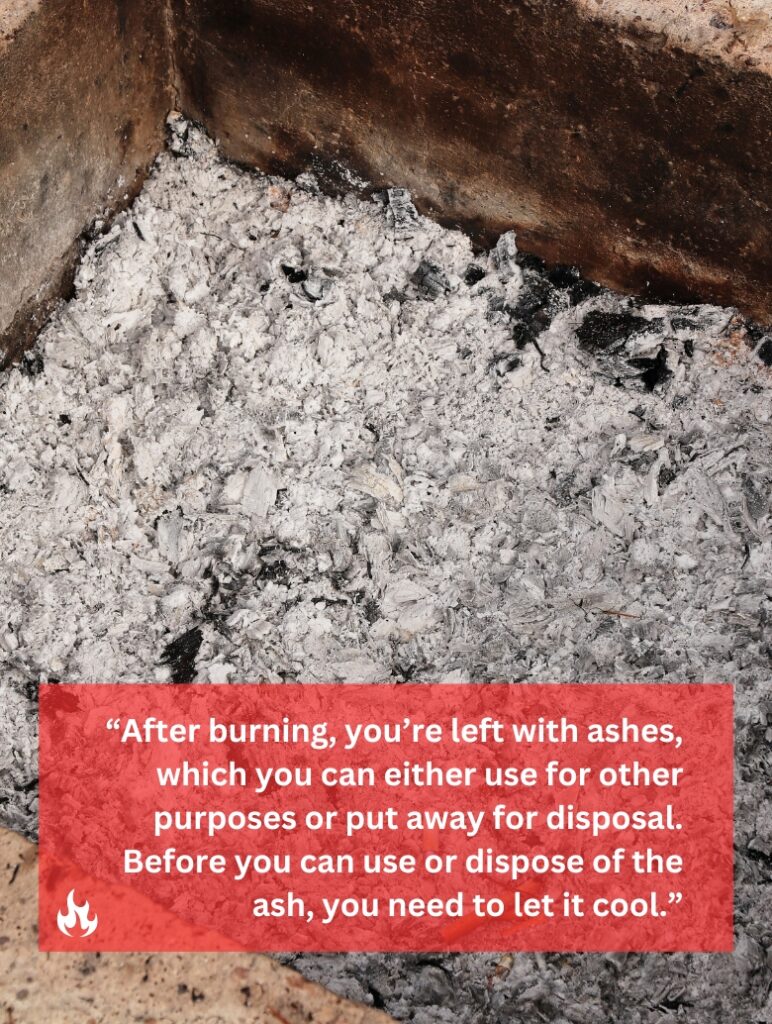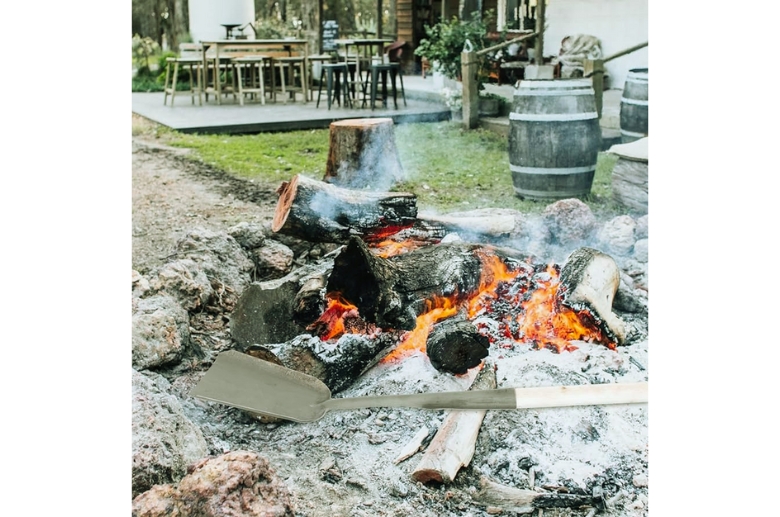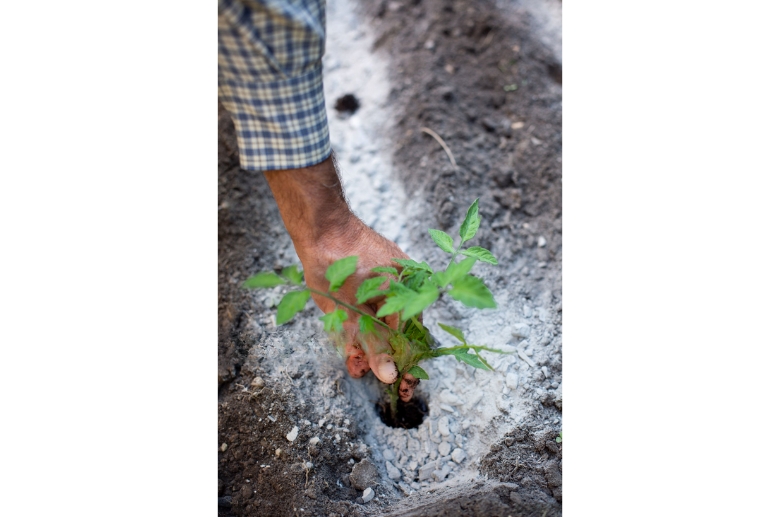If you have a firepit that you constantly burn wood in, you’re probably wondering what to do with the leftover fire pit ashes. There’s so much, and it would be a waste to throw it all away.
The wonderful thing about fire pit ashes is that they are rich in minerals; their use goes beyond the fireplace and can be applied in gardening, animal care, glaze making, and household cleaning.
By the end of this article, you’ll learn so many of its uses that you won’t ever think of getting rid of those ashes again.
What To Do With Fire Pit Ashes After Burning?

After the fire dies down, you’re left with ashes that can be either repurposed or prepared for disposal. However, an essential first step is ensuring the ashes have completely cooled to prevent accidental fires. It’s a common misconception that ashes cool quickly. In reality, they require at least four days to lose all residual heat, as ashes can retain sufficient warmth to potentially reignite.

To safely manage the cooling process, it’s advisable to leave the ashes where they were generated for about 24 to 48 hours as a preliminary cooling period. After this time, it’s crucial to make sure that the ashes have fully cooled. Employ a fireplace poker to sift through the ashes, checking for hidden embers.
A clear indicator of completely cooled ashes is a consistent white color without any smoke production. This thorough check ensures the ashes are safe to handle, whether for use in various applications or safe disposal.
How Can I Safely Clean Out Ashes From A Fire Pit?
Handling ash from fire pits requires precautions similar to those for dealing with other high-alkaline substances, such as household bleach. It’s essential to wear protective gear, including gloves, to shield your hands from potential burns. Eye protection is necessary to guard against ash particles, while an N95 respirator is advisable for lung protection, as it efficiently filters out harmful particles.
Before disposing of or repurposing fire pit ashes, transfer them to a metal container using a shovel or scoop. To minimize dust and potential reactivity, add a slight amount of water to the ashes before sealing the container with a lid. These metal containers are readily available at hardware stores.
Avoid using a vacuum cleaner for ash removal. They are not equipped to handle the heat and could inadvertently suck in smoldering coals. This poses a fire risk, especially if hot coals come into contact with the vacuum’s paper filters.
For disposal, never place ashes directly into a garbage can, cardboard box, or paper bag due to fire hazard concerns. Instead, securely encase the ashes in a plastic garbage bag before placing them in the trash to ensure safe handling and disposal.
——
Do You Need to Hire Chimney & Fireplace Expert?
Get free quotes from qualified experts near you. No commitment required!
——
12 Creative Ways to Use Fire Pit Ashes
Now that you know how to safely handle fire pit ashes, let’s take a look at some creative ideas for using them in your home.
1. Natural De-Icer for Winter
Leverage the natural properties of fire pit ashes as an eco-friendly alternative to conventional de-icers. Rich in potassium, a key component also found in commercial de-icing salts, ashes offer a less corrosive option for your driveways and walkways, safeguarding both concrete surfaces and metal fixtures from damage.
Furthermore, the dark color of ashes increases sunlight absorption, accelerating the ice-melting process without the environmental toll of chemical de-icers. This method not only utilizes waste productively but also enhances safety by reducing slip hazards during the frosty months.
So the next time you need to melt snow and icy surfaces on your walkway and driveway, grab your bucket of ash and sprinkle it on the surface.
2. Pest Deterrent in the Garden

Fire pit ash serves as an excellent natural deterrent against common garden pests, including slugs, snails, caterpillars, grasshoppers, and worms. The secret to its effectiveness lies in the ash’s ability to induce desiccation, a process where these pests lose moisture rapidly due to their moist bodies’ aversion to ash. This not only dries them out but also makes treated leaves less appealing as a food source.
Gently sprinkle a fine layer of sieved wood ash over the plants you wish to protect. Sieving the ash beforehand helps remove any large pieces of debris, ensuring a fine, even coverage.
It’s important to remember that wood ash maintains its pest-repelling properties only while dry. Therefore, after any rainfall or irrigation, it’s necessary to reapply the ash to maintain its effectiveness in keeping your garden pest-free.
3. Mice Deterrent
The scent of wood ash naturally deters mice, making it an eco-friendly and safe method of managing minor infestations without resorting to harsh chemicals or traps.
When applying wood ash as a deterrent, focus on entry points, potential nesting areas, and paths commonly traveled by these rodents. A thin layer of ash is sufficient, as too much can be easily dispersed by the wind or become ineffective when wet.
Monitor these areas regularly and reapply after cleaning or rain to maintain their effectiveness. This approach not only helps keep mice at bay but also utilizes the byproduct of your fire pit or fireplace in a practical and environmentally conscious manner.
4. Household Cleaning and Polishing
Wood ash can be used as a multi-purpose household cleaner due to its mildly abrasive qualities.
To utilize this, simply mix wood ash with a little bit of water to create a paste. This natural cleaner is effective for buffing up metals and silverware, as well as cleaning items like glasses, jewelry, stove tops, and car headlights.
The paste works by gently scrubbing away grime and oxidation without damaging the underlying material, making it an ideal choice for delicate surfaces.
Additionally, it’s a cost-effective and environmentally friendly alternative to chemical cleaners, leveraging a natural byproduct of your fireplace or fire pit for household maintenance tasks.
5. Odor Neutralizer

Ash, with its natural ability to neutralize acids and absorb volatile organic compounds, serves as an exceptional odor neutralizer.
This makes it perfectly suited for use in parts of your home plagued by strong, persistent smells, such as refrigerators, trash cans, and pet areas.
The process is straightforward: Place wood ash in a small bowl and set the bowl in the affected area, or, for a more direct approach, sprinkle the ash directly onto the surface in question. Wood ash’s porous nature allows it to quickly absorb and neutralize unpleasant odors, restoring freshness to your environment.
In addition to these common household areas, wood ash can also be used in musty basements or garages, closets that retain a damp smell, or even in shoes to eliminate foot odor. For a more sustained effect, replacing the ash every few days ensures continuous odor absorption.
This method not only efficiently combats unwanted smells but does so in a non-toxic, eco-friendly manner, avoiding the use of artificial fragrances or chemicals that merely mask odors rather than eliminating them at the source.
6. Gardening and Lawn Care
Wood ash can be an excellent supplement for gardens because it’s rich in minerals like calcium, magnesium, phosphorus, and potassium. The minerals in wood ash also protect plants from frost damage by lowering the freezing point of water without hurting the plant tissue.
Add the ash to your compost mixture to boost its nutrient content. Before using ash in your garden, pay attention to soil quality. Wood ash is alkaline, so do not use it on soil with a pH level of 7.5 or higher. You only want to use it on acidic soil to help neutralize it. It raises the pH to make more nutrients available to the plant.
If you have a water feature in your home, such as a pond or a fountain, you can use a little bit of wood ash (1 tablespoon per 1,000 gallons of water). This will slow down the growth of algae and give other plants a chance to grow.
7. Dehumidifier
Ash has hygroscopic properties, which means it readily takes up moisture. If you constantly have high levels of humidity in your home, you can dehumidify it with a little bit of wood ash by placing a cup of wood ash in a bowl in damp areas of your home, like basements or bathrooms, you can reduce excess humidity.
Remember to replace the ash once it becomes damp to maintain its effectiveness. This eco-friendly method is efficient and cost-effective, offering a simple solution to indoor moisture problems without needing electrical dehumidifiers.
8. Chicken Supplement
Wood ash, with its rich calcium and potassium content, can be a wonderful supplement for your chickens. Add a 1% to 2% ratio of wood ash to your chicken feed and enjoy the benefits of better egg-laying rates and extended laying periods.
You may also add wood ash to the waterer to filter out impurities such as algae and other bacteria. It keeps the water clear and rich in minerals that your chicken can drink.
9. Animal Care
Wood ash serves as a versatile addition to your chicken coop, offering a range of benefits to enhance the well-being of your poultry. Adding wood ash into your chickens’ dust bath not only boosts its effectiveness in warding off pests but also utilizes the natural repellent properties of potassium and calcium found in ash to combat lice and mites.
Additionally, wood ash’s antibacterial qualities make it an excellent remedy for treating minor wounds on your chickens, promoting healing and preventing infection.
10. Art and Craft
Wood ash has been a staple in lye production for hundreds of years, where it serves as a key ingredient in the traditional soap-making process. By combining lye, which is created from the mixture of water and wood ash, with animal fat, one can produce soap.
This method showcases the enduring utility of wood ash in crafting basic household necessities.
Furthermore, wood ash is also utilized in pottery, specifically in the glazing of ceramic wares. Before its application as a glaze ingredient, the ash must undergo a thorough sieving process to ensure its suitability for creating a smooth and appealing finish on ceramics.
This use of wood ash in pottery not only highlights its versatility but also contributes to the creation of unique and beautiful glaze effects, demonstrating the material’s continued relevance in both practical and artistic domains.
11. Oil Spill Cleanup
Got an oil spill that’s stubborn to clean?
Use wood ash and let it sit overnight. Its potent absorbent qualities make wood ash an ideal solution for tackling oil spills and stains. Simply sprinkle a generous amount over the affected area and allow the ash to work its magic by absorbing the oil.
The next day, armed with a broom, sweep away the ash. You’ll be pleasantly surprised to find that the wood ash has effectively absorbed the oil stains, leaving the surface much cleaner and oil-free.
This method not only offers an eco-friendly approach to dealing with spills but also utilizes a common byproduct of wood burning, making it a cost-effective cleaning solution.
12. Skin Care

Activated charcoal, derived from wood ash, is imbued with antibacterial properties, rendering it an exceptional remedy for treating cuts and scrapes. Its ability to prevent bacterial infections makes it a valuable addition to home first aid kits.
In addition to its medicinal uses, wood ash can be employed as a natural solution for cosmetic concerns. For instance, it can effectively remove dark color stains from your hands that often result after using hair dye.
Simply dab a wet cloth in wood ash and gently wipe it over the stained areas. The ash acts as a mild abrasive, lifting the dye from the skin without the use of harsh chemicals, leaving your hands clean and stain-free. This showcases the versatility of wood ash, highlighting its utility in both healthcare and personal care routines.
——
Do You Need to Hire Chimney & Fireplace Expert?
Get free quotes from qualified experts near you. No commitment required!
——
Tips for Storing Fire Pit Ashes Properly
For you to get the most out of your wood ash, you need to know how to store it properly. Here are tips to help you accomplish that.
- Wood ashes should be stored inside a metal bucket container with a tight lid cover. The lid helps prevent air from blowing into the container, which can reignite any embers.
- Place the metal container at least 10 feet away from anything flammable.
- Do not put the container for your wood ashes near your wood deck or porch. Instead, place it on concrete, stone, or brick surfaces. This is just in case an ember escapes the metal bin.
- Do not store wood ashes outside on a windy day. This could ignite embers that could still be present.
Conclusion
Fire pit ashes are very versatile; they can be used for your garden, chicken coop, household, and even your DIY projects.
There are plenty of reasons to keep ashes around. However, you must follow the safety measures we discussed above to ensure you don’t start a fire in your home. If you do decide to get rid of the ashes, do it responsibly to prevent any inhalation or fire hazard.






